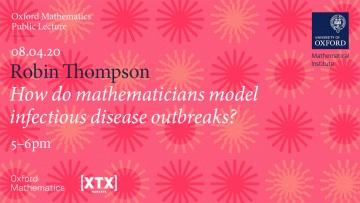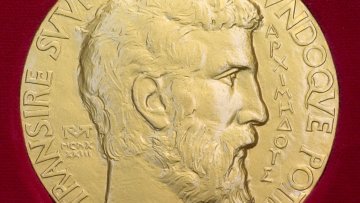14:15
Geometry from Donaldson-Thomas invariants
Abstract
I will describe an ongoing research project which aims to encode the DT invariants of a CY3 triangulated category in a geometric structure on its space of stability conditions. More specifically we expect to find a complex hyperkahler structure on the total space of the tangent bundle. These ideas are closely related to the work of Gaiotto, Moore and Neitzke from a decade ago. The main analytic input is a class of Riemann-Hilbert problems involving maps from the complex plane to an algebraic torus with prescribed discontinuities along a collection of rays.
Models. They are dominating our Lockdown lives. But what is a mathematical model? We hear a lot about the end result, but how is it put together? What are the assumptions? And how accurate can they be?
In our first online only lecture Robin Thompson, Research Fellow in Mathematical Epidemiology in Oxford, will explain. Robin is working on the ongoing modelling of Covid-19 and has made many and varied media appearances in the past few weeks. We are happy to take questions after the lecture.
The International Congress of Mathematicians (ICM) that was held in Oslo in July 1936 was a unique event that took place in turbulent times, research by Oxford Mathematician Christopher Hollings has revealed.
Robin Thompson - How do mathematicians model infectious disease outbreaks? ONLINE LECTURE
Models. They are dominating our Lockdown lives. But what is a mathematical model? We hear a lot about the end result, but how is it put together? What are the assumptions? And how accurate can they be?
In our first online only lecture Robin Thompson, Research Fellow in Mathematical Epidemiology in Oxford, will explain. Robin is working on the ongoing modelling of Covid-19 and has made many and varied media appearances in the past few weeks. We are happy to take questions after the lecture.
Watch live:
https://twitter.com/oxunimaths?lang=en
https://www.facebook.com/OxfordMathematics/
https://livestream.com/oxuni/Thompson
Oxford Mathematics Public Lectures are generously supported by XTX Markets
15:30
Maximum height of 3D Ising interfaces
Part of the Oxford Discrete Maths and Probability Seminar, held via Zoom. Please see the seminar website for details.
Abstract
Dobrushin (1972) showed that, at low enough temperatures, the interface of the 3D Ising model - the random surface separating the plus and minus phases above and below the $xy$-plane - is localized: it has $O(1)$ height fluctuations above a fixed point, and its maximum height $M_n$ on a box of side length $n$ is $O_P(\log n)$. We study this interface and derive a shape theorem for its "pillars" conditionally on reaching an atypically large height. We use this to analyze the maximum height $M_n$ of the interface, and prove that at low temperature $M_n/\log n$ converges to $c\beta$ in probability. Furthermore, the sequence $(M_n - E[M_n])_{n\geq 1}$ is tight, and even though this sequence does not converge, its subsequential limits satisfy uniform Gumbel tails bounds.
Joint work with Reza Gheissari.
14:00
Ryser's conjecture and more
Part of the Oxford Discrete Maths and Probability Seminar, held via Zoom. Please see the seminar website for details.
Abstract
A Latin square of order n is an $n \times n$ array filled with $n$ symbols such that each symbol appears only once in every row or column and a transversal is a collection of cells which do not share the same row, column or symbol. The study of Latin squares goes back more than 200 years to the work of Euler. One of the most famous open problems in this area is a conjecture of Ryser, Brualdi and Stein from 60s which says that every Latin square of order $n \times n$ contains a transversal of order $n-1$. A closely related problem is 40 year old conjecture of Brouwer that every Steiner triple system of order $n$ contains a matching of size $\frac{n-4}{3}$. The third problem we'd like to mention asks how many distinct symbols in Latin arrays suffice to guarantee a full transversal? In this talk we discuss a novel approach to attack these problems. Joint work with Peter Keevash, Alexey Pokrovskiy and Benny Sudakov.



